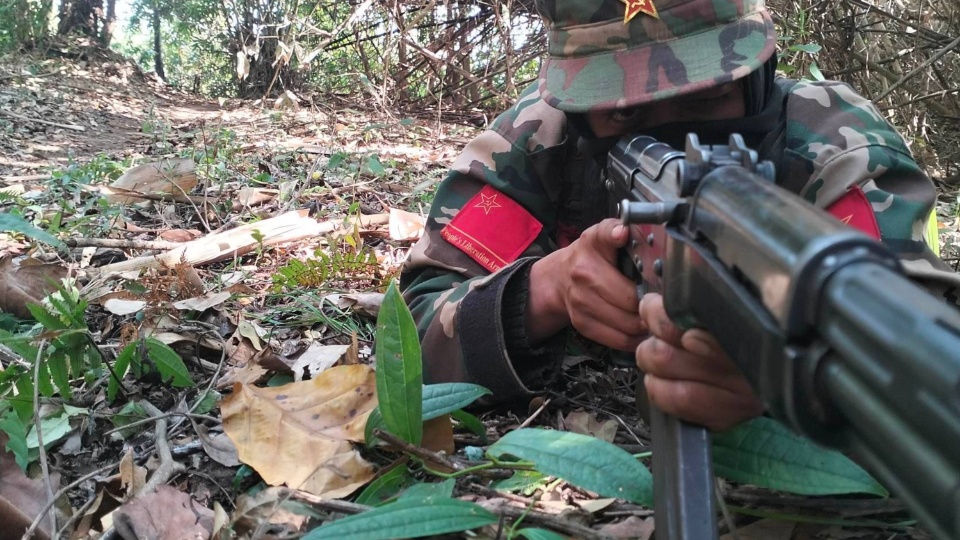“Why can’t they wait for the new government to sort out? ‘All in good time,’ and ‘they must wait for their turn,’ they say. When you don’t know where your next meal is coming from, when your children go hungry, how long are you willing and prepared to wait?”
— Popular Struggle, Communist Party of Burma, June 20, 2016.
Khing Hnin Wai started her day like any other. A resident of Naypyidaw, the capital of Myanmar—formerly known as Burma—she spent many mornings recording aerobic exercise videos for her online followers. On the morning of Feb. 1, 2021, as Khing Hnin Wai did her exercises, however, her video feed captured footage that shocked the world: a military convoy’s arrival at parliament.
The Grand Army of Myanmar, known as the Tatmadaw, had initiated a military coup. Khing Hnin Wai, oblivious to what was happening behind her, had unintentionally filmed the Tatmadaw’s operation to seize control of the civilian government. State Counsellor Aung San Suu Kyi—the famed leader of the Burmese democracy movement—was arrested.
In the immediate aftermath of the coup, the country was plunged deeper into disarray. Since gaining its independence in 1948, Myanmar has been plagued by a never-ending series of insurgencies, uprisings, and other internal conflicts.
As General Min Aung Hlaing inaugurated a new military dictatorship in the wake of this latest coup, popular protests and armed resistance swept the country. As unrest spread and government repression intensified, more groups rose up, including new ones that had formed as a result of the coup and instability in its aftermath. Also re-appearing were older movements that had previously ceased to exist—or so it was thought.
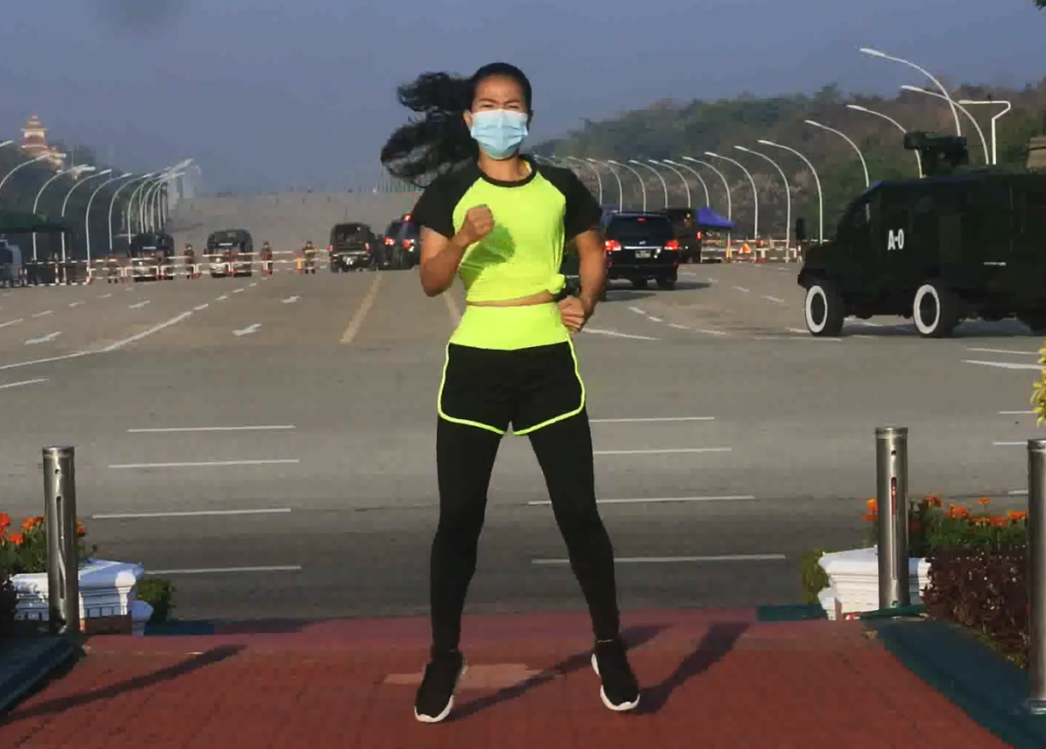
Red revival
While the Communist Party of Burma (CPB) had released statements sporadically over the last several decades, a period of internal instability in the late 1980s had resulted in several organizations splitting away from the once-powerful political group—most notably the United Wa State Party (UWSP), which now governs the de facto independent Wa State in eastern Myanmar.
Following the events of that period, English-language reporting on the CPB ran cold. Although some loyalists maintained a party website since the late-1990s, the presumption was that any remaining leaders were all either killed, in hiding, or in exile neighboring China. For all intents and purposes, it appeared the CPB was defunct.
Less than 24 hours prior to the military coup, however, on Jan. 31, 2021, a statement was released by the CPB seemingly out of nowhere. The party warned of what was to come, and reaffirmed its rejection of the earlier 2008 constitutional referendum, which had been overseen by a previous military government.
Likewise, the party asserted its opposition to another military government taking power in the country. Shortly thereafter, as reported by Morning Star and People’s World, the CPB announced the formal re-establishing of the People’s Liberation Army (PLA). Not only was the Communist Party of Burma back, it was armed and ready to do battle against the dictatorship.
Given the chaos of the situation, conflicting reports and assessments, as well as a general lack of readily available information, many questions were raised as to the legitimacy of the statements issued in the name of the CPB. Questions swirled among those resisting the military and observers in the region about the trustworthiness of what little was being released.
Many found the timing of these events suspicious and noted that the U.S. foreign policy establishment seemed very keen to support so-called “pro-democracy” forces—a common trope in campaigns of destabilization. Truth, however, is often far stranger than fiction, as this author soon discovered.
Shortly after relocating to Laos in 2022, more than a year after the coup in Naypyidaw, I was introduced to a source living in Myanmar who had strong opinions regarding the current political situation: U.S. interests are at play in the region, but the military junta also maintains a tight grip on power that most (especially younger) Burmese people do not want. I inquired about the alleged resurgence of the Communist Party.
The following article is based the ensuing discussions with two individuals affiliated with the Communist Party of Burma and the People’s Liberation Army. They were recorded between March and April 2023.
Generational transition amidst political instability
Mr. Champo is a friendly, energetic middle-aged man involved in the local business community. His associate, Mr. Denpo, is an equally energetic older scholar. Both men declined to share the details of their affiliation or to speak about how long they had been involved in political affairs. For safety reasons, pseudonyms have been used for both.
Mr. Champo explained that a delineation exists in the CPB between “old cadres” and the “youth generation,” with the former teaching the latter. It appears that the ideological positioning of the CPB is in line with its official public statements of adherence to “Marxism-Leninism-Mao Zedong Thought.” Given the overall rural character of Burmese society and the central role of agriculture in its economy, this more peasant-based ideological focus is not so surprising. While in word it aligns more with the views of Mao-era China, the CPB has also eschewed what it describes as both “left” and “right” deviations.
There does appear to exist a degree of diverse thought within the party, though, especially given the generational divide. As Mr. Champo noted: “Some old [CPB] cadres may be Maoists, and some may be socialists.” In the context of this discussion, the term “Maoist” was used to imply an affinity for the political views of late-1970s China and is not related to later movements elsewhere who’ve adopted some version of Mao’s thinking. Similarly, “socialist” implies something more akin to what Westerners might call democratic socialism or social democracy.
Despite such differences, Mr. Champo noted that “solidarity is emerging” across the age gap, as the older cadres share their experiences and guidance with the youth. Political differences between the age cohorts appear to largely coincide with the different historical conditions that affected each of them. According to some reports, the older generation were supported heavily by Mao-era China, with some party leaders being driven into exile in China on at least two occasions. By contrast, the youth have primarily gained experience through domestic student organizing and navigating the post-1980s political landscape of military rule.
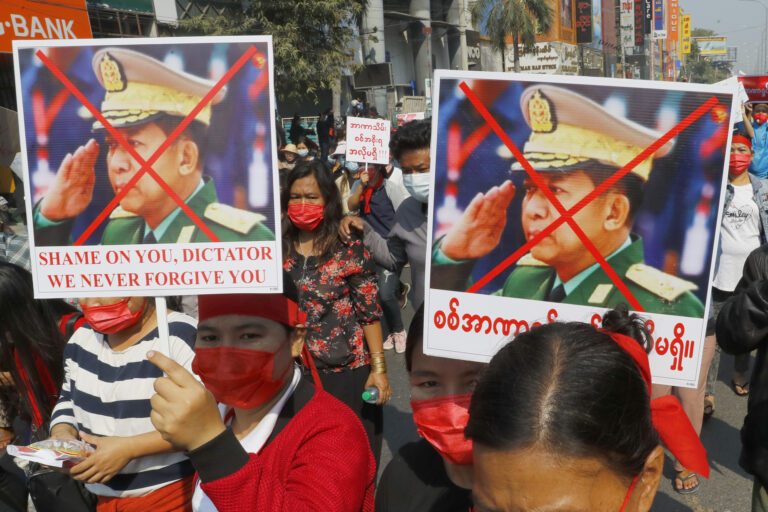
This is likewise reflected in attitudes towards both the Communist Party of China (CPC) and United Wa State Party (UWSP). Mr. Champo said he could neither confirm nor deny rumors that the CPB is currently supported by either organization and suggested that views towards those two organizations varied within the CPB.
Setting aside questions of any organizational “alliances,” Mr. Champo said the CPB is highly active in union and community organizing across Myanmar. Many, he says, call themselves “leftists” or “reds” without having received training or education in political ideology or revolutionary strategy—a key void that the CPB is seeking to fulfill.
“Their unity,” he stressed, “is [based] upon individual issues and political situations.” In other words, the image one gets of the fluidity and ever-shifting situation in Myanmar’s political landscape is not merely a result of bad reporting. It is also a reflection of the fluidity and ever-shifting relations between the numerous organizations and actors on the ground.
Mr. Champo lamented the situation, attributing Myanmar’s continuous instability over the past seven decades to “military gangsters and the rotten politicians.” The revolutionary forces lack strong leadership, he said, and this is something the Communist Party is seeking to correct.
A variety of tactics for a variety of struggles
When asked about the history and current situation of the party, the two men were able to offer some clarity. They confirmed the existence of the People’s Liberation Army (PLA) as the armed wing of the CPB and offered further details on its operations. Strikingly, they shared that the PLA, contrary to popular belief, is not merely concentrated in the northern areas along the Chinese border.
While officially holding no territory, the PLA “is like a ghost troop” that operates throughout the country. Not only are is it active in the north (described as the “2nd Front”), where it maintains at least two full battalions, it is also engaged in the south, along the coast near the Thai border (“1st Front”), as well as in the central areas of the country (“3rd Front”). In actuality, the men say, the only area where the PLA currently isn’t active is in the western areas near the Indian border.
Questioned about the continuity of the PLA and CPB as they exist today with their previous operations during the 1980s, both men balked. According to Mr. Champo, the party’s headquarters had been moved in 1989, roughly corresponding to the period of internal strife. However, those years, they said, are “difficult to talk about” and that information was “restricted.” One simply remarked, with a frown, “Danger.” They were able to confirm that the current chief of the PLA is in fact an “old cadre” from the CPB, but any further details were off the table.
The policies supported by the CPB today mirror both historic policy positions supported by Communist Parties around the world during the Second World War, as well as those expressed by ruling parties in neighboring China and Laos. When asked what the CPB’s goals are at this time, they said the first task is to end the military dictatorship. The second, once the dictatorship is ended, is to win full liberation and people’s democracy, to build real “people power” in the country.
They envision a people’s democracy for Myanmar structured as a federated state, wherein all of the various ethnic groups and autonomous regions will be respected and united together under one government while still being allowed to oversee their own affairs. This policy has been upheld by the CPB for as long as it has existed and puts it in a position sometimes at odds with other ethno-nationalist separatist organizations in the country seeking complete independence.
Furthermore, the party envisions the construction of this “people power” as a process of “three revolutions”—cultural, economic, and technological. People’s World readers may note that this policy, which the CPB attributes to Chinese leader Mao Zedong, was also undertaken by Lao leader Kaysone Phomvihane following the establishment of the Lao People’s Democratic Republic in 1975.
When asked if the CPB participated in elections, both men laughed. No elections have been held in the country since the Tatmadaw seized power in 2021, and while elections are supposedly planned for August of this year, the common view appears to be that such a vote (if it isn’t postponed) will be little more than an attempt to legitimize the military regime.

The CPB, which remains legally banned, will likely reject anything less than a full return to civilian rule. In the view of the CPB, Myanmar has spent “over 100 years under tyranny.” Mr. Champo and Mr. Denpo described the political situation generally as “slave and master,” remarking that in order to correct the country’s course, “We need a revolution.”
It would be a mistake to identify such rhetoric as merely warmongering or longing for violence, however. Elaborating further on the history of political struggle in their country, both men were quick to highlight that the CPB has learned hard lessons from its struggle for liberation. So-called “hardlining,” or ultra-leftism, was once a real problem. With the rise of the “second generation” of leaders in the Communist Party of China (corresponding with the period of Deng Xiaoping’s economic reform), the CPB undertook changes of its own; overemphasis on ideological rigor took a back seat to practicality.
“People need to eat, people have to live,” Mr. Champo said of the realizations of that time. “First, the people need to eat, then we can change their thinking.” Given that the time during which this rectification occurred (the late-1980s) corresponds with the party’s return to underground organizing, further inquiry regarding the exact developments that occurred was not possible.
It is perhaps noteworthy, however, that prior to the period in question, two senior leaders of the CPB had been denounced as “the Burmese Deng Xiaoping” and “the Burmese Liu Shaoqi”—referring to the two pragmatic Communist leaders purged by Mao—before being executed. Such violent and zealous actions were in line with the style of political discourse occurring in the latter period of China’s Cultural Revolution. With the death of Mao, such political maneuvers were ended and rightly regarded as a mistake. It is unclear whether the CPB today holds the same opinion of its own ultra-leftist period. As for the party’s focus today, however, Mr. Champo explained it straightforwardly: “We are very simple, we want to liberate the people.”
The men both agreed that learning the history of Myanmar is very difficult, as all sides maintain an interest in how things are remembered—and what things are forgotten. Burmese independence in the late 1940s, they say, was merely a “trade-off” with British authorities. The Communist Party hopes to achieve “the whole thing.” While some cadres do utilize the internet, including Facebook, as a means for spreading the party’s message, the majority of content is in Burmese, and is therefore less accessible to Western audiences. Other sources have indicated to People’s World that internet and electricity blackouts remain a common occurrence, especially in the cities, hampering the party’s online organizing.
Finally, the conversation ended with a question the interview subjects found humorous: “What is the CPB/PLA’s view of the United States and alleged U.S. involvement in the conflict in Myanmar?” Both men grinned, and Mr. Champo provided a diplomatic assessment: “The U.S. is very clever.” It will come as no surprise that the party believes foreign interests are at play in stoking the ongoing conflict in their country or that, in general, they have a negative view of U.S. foreign policy and involvement in their region.
A people’s army
While Mr. Champo and Mr. Denpo discussed history and politics, a group of soldiers had excitedly gathered in the unnamed location, somewhere deep in the Burmese jungle, eager to listen and watch. Their woodland camouflage uniforms were decorated with bright red epaulets and patches emblazoned with writing in Burmese.
“Comrade Thet,” speaking on condition of total anonymity, is a People’s Liberation Army commander, fighting on the 2nd Front in northern Myanmar, where the PLA claims at least two full battalions (roughly 2,000 men) are based. A young woman assists in translating; Thet explains that she is his wife. Beside him sit an unnamed Lieutenant, who leads a column of riflemen, and a likewise unnamed Supply Officer, who assisted in making the meeting possible.
These seasoned guerillas all appear quite young, perhaps in their 20s or 30s. Their wide smiles are matched only by the gleam of the bright five-pointed stars affixed to their caps. If not for their uniforms and black assault rifles, one would assume they were all students. This is not a coincidence, as Thet explained they were in fact students until the military coup in 2021.
Beneath their polished uniforms and grins lay a stern commitment and a determined outlook: Forced by circumstance to trade their school books for bullets, those who have survived are now battle-hardened revolutionaries.
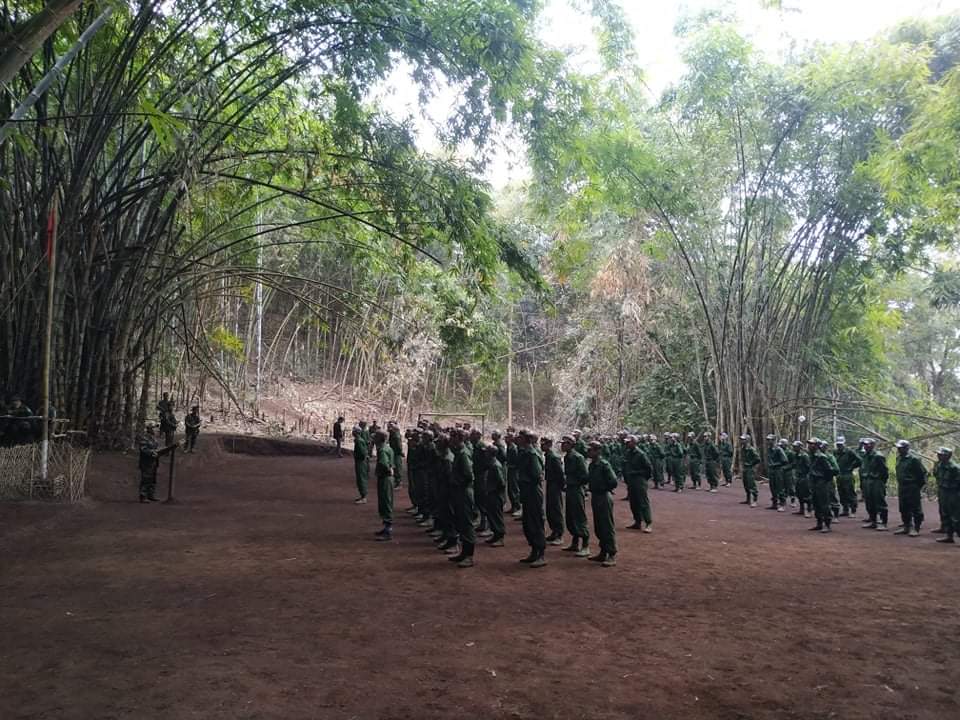
In 2015, Thet was an organizer with his local student union. While pursuing democratic education reforms, he first came into contact with “old comrades” from the Communist Party. The Communists, he said, had been a major supporter of democratic reforms and especially focused on improving the livelihoods of farmers and workers. When, in 2021, the Burmese military seized power and established the dictatorship, the party called for revolution.
“A difficult choice had to be made,” Thet said, but as the military increased its attacks against democracy activists, the answer, for them, became clear. On March 15, 2021, they mobilized. One month later, in April 2021, the first armed battle took place against the junta’s forces: 13 comrades were martyred.
The meeting formally begins with introductions, as well as confirmation that recent local reports are accurate: On April 11, 2023, mere days before the Burmese New Year (Thingyan) festival, government jets and gunships unleashed an unprecedented bombardment on the village of Pazigyi, in north-central Sagaing region.
Attempts to rescue survivors and to collect the corpses of the men, women, and children who had perished, were postponed as another wave of bombardment followed. While official accounts estimate around 160 casualties, Thet confirms at least 200 civilians were killed.
In response, anti-junta troops under the flag of the People’s Defence Forces (PDF)—the broad coalition fighting against what they describe as a military dictatorship, of which the PLA is a participant—carried out an ambush against government forces during the holiday weekend.
Mr. Champo explained that the Burmese military’s strategy has been changing. The use of aerial bombardment, helicopters, and gunships has increased. As seen in Pazigyi, “They burn villages and kill groups of villagers.” Mr. Champo said this has led to a general division in society, with the “Greens” supporting the military, sometimes for no other reason than fear, and the “Reds,” consisting of a large coalition of different organizations and camps whose overarching goal is to end the dictatorship.
Thet spoke further of conditions on the ground, sharing that the military’s increasing brutality has resulted in growing support for the Communist Party and the People’s Liberation Army. In northern Myanmar, he says, the people have only one choice: to fight. The increasingly violent crackdowns by the dictatorship, rather than breaking the people’s will to fight for freedom, is instead making more and more of them come to terms with what the CPB describes as the necessity for revolution.
“We have to end this war by war,” he said. “An eye for an eye; we have no choice.” In this pursuit, the Communist Party seeks to play a central role in organizing workers, farmers, students, and other laborers in order to fight for their democratic and human rights. “PLA has the biggest responsibility for the revolution and organizing people to fight back for their liberation,” Thet said.
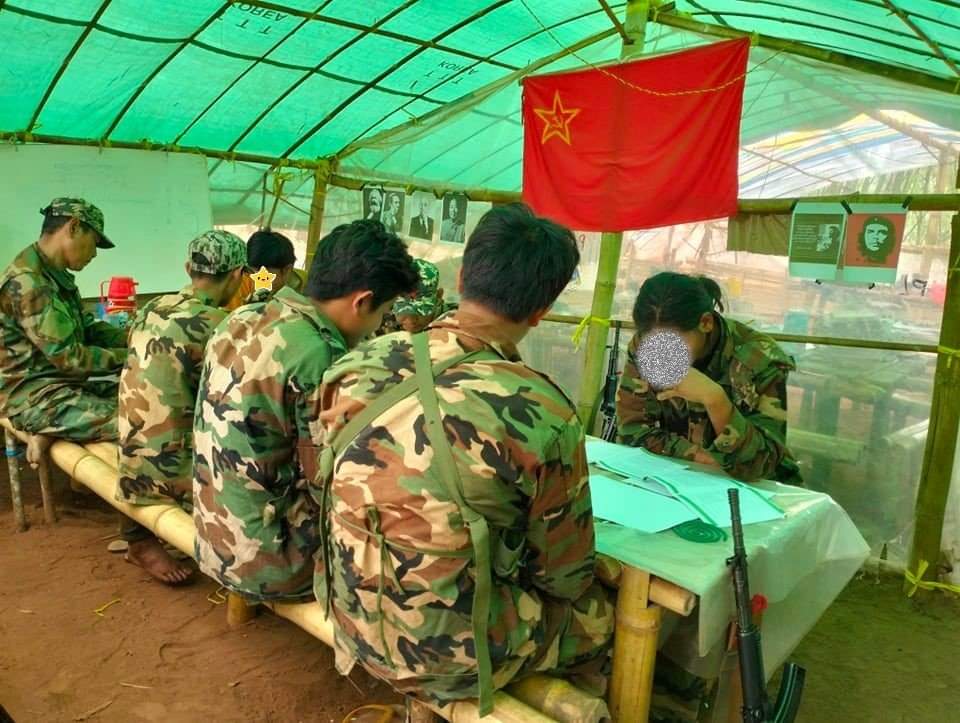
This mentality is reflected in the strategies implemented by the Communist fighters. Thet stressed the necessity for good strategy and tactics, sharing that his force undergoes daily training, both in military arms, as well as political philosophy. “We obey the guidance of the Long March,” he said, alluding to the grueling year-long retreat and reorganization of Chinese Communist forces in 1934-35. Historians regard it as a watershed moment in the history of the Communist Party of China, the time when Mao Zedong’s leadership cemented his role as chairman and saved the CPC from total destruction during the Chinese Civil War.
While studying military organization and fighting skills, the Burmese revolutionaries also undergo intense training in Communist ideology. Their zeal and drive to serve the people is expressed in their bright smiles and proud faces. Following the line that “the party commands the gun,” they explained that their primary strategy isn’t to hold specific territory for long periods of time. Rather, they move from area to area, a ghost troop, as Mr. Champo had said, combatting government forces and working to organize local people wherever they go.
“People are people,” the commander said, and the PLA’s goal is to help organize wherever the people are. So far, it appears to be working. “We have continuously overrun [the junta] and tried to expand our area of operation,” he said. The PLA hopes that as their area grows, and the people become more organized, the junta will eventually be overpowered.
The brutality and violence of war is not to be romanticized, however, and the PLA knows that many challenges lie ahead. “Material conditions are difficult,” Thet said. While the vast majority of Burmese society are farmers and workers, the bourgeois elites would prefer prolonged brutal conflict, if necessary, rather than lose the wealth they’ve gained through exploitation and tyranny.
“Wherever the people are struggling, we try to support them and organize them to fight for democracy and human rights.” This requires manpower and resources, and while the revolutionaries appear to be faring well enough, they are under no illusions as to the difficulty of the task ahead.
Nevertheless, their caps shine brightly in the hot Burmese sun—just like their commitment. They show determination in the face of what skeptics might say is certain death against the professionally-trained and technologically superior forces of the dictatorship. But their resolve is evidence of their commitment to build the Party, win people’s power, and, someday, they hope, establish a people’s democracy with human rights and dignity for all.
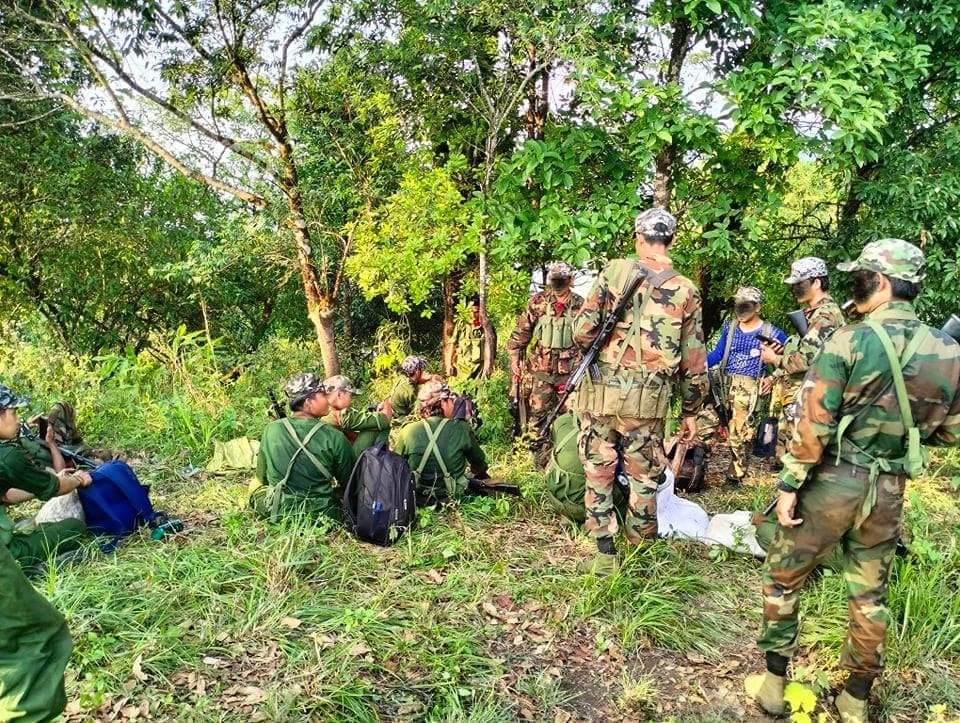
As the meeting ends, I asked Thet if there’s a message he would like to share with the readers of People’s World and people living in the West. The revolutionary commander said that he hopes readers will be interested in learning about the situation in Myanmar and that solidarity can be built around supporting the people’s fight for democratic and human rights.
“I want to share with everyone what is happening in Myanmar and to share that the PLA is currently fighting against the dictatorship. I want to share what is happening and who we are.”
He concluded that, in the future, he hopes volunteers, technicians, and aid workers will come to Myanmar and help them build the people’s democracy they have fought and bled for.
“Please share this with the people of the world.”
Michael Christopher
Former secretary of the Virginia District of the Communist Party USA

